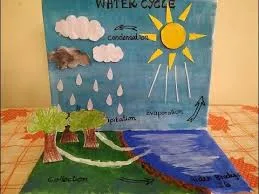Earth is a complex and dynamic planet, governed by intricate systems that sustain life. From the movement of tectonic plates to the circulation of ocean currents, these processes shape our environment in fascinating ways. Among these, the water cycle model plays a crucial role in distributing water across the globe, ensuring ecosystems thrive. In this article, we’ll explore various natural phenomena, their significance, and how they interconnect to maintain Earth’s delicate balance.
The Forces That Shape Our Planet
Plate Tectonics: Earth’s Moving Puzzle
The Earth’s crust is divided into massive plates that constantly shift, collide, and pull apart. This movement causes earthquakes, volcanic eruptions, and the formation of mountain ranges. Over millions of years, plate tectonics have shaped continents and influenced climate patterns.
Ocean Currents: The Planet’s Conveyor Belt
Ocean currents distribute heat around the globe, regulating temperatures and weather systems. Warm currents, like the Gulf Stream, bring milder climates to coastal regions, while cold currents influence marine ecosystems. These currents also play a role in nutrient distribution, supporting aquatic life.
Wind Patterns: Nature’s Invisible Force
Global wind patterns, such as trade winds and jet streams, drive weather systems and influence climate zones. These winds help disperse seeds, shape landscapes through erosion, and even assist in the migration of birds and insects.
The Role of Water in Earth’s Systems
The Hydrologic Cycle: A Continuous Journey
Water is constantly in motion, evaporating from oceans, condensing into clouds, and precipitating as rain or snow. This water cycle model ensures freshwater reaches land, replenishing rivers, lakes, and groundwater. Without this cycle, life as we know it would not exist.
Wetlands: Nature’s Water Filters
Wetlands act as natural sponges, absorbing excess water during floods and filtering pollutants. They provide habitats for diverse species and help mitigate climate change by storing carbon. Protecting these ecosystems is vital for maintaining water quality and biodiversity.
Glaciers: Frozen Reservoirs
Glaciers store vast amounts of freshwater and slowly release it into rivers. As climate change accelerates melting, sea levels rise, affecting coastal communities. Studying glaciers helps scientists predict future water availability and environmental changes.
The Interconnectedness of Life and Environment
Forests: The Lungs of the Earth
Forests absorb carbon dioxide, produce oxygen, and regulate temperatures. They also influence rainfall patterns by releasing moisture into the atmosphere. Deforestation disrupts these processes, leading to climate imbalances and habitat loss.
Coral Reefs: Underwater Biodiversity Hotspots
Coral reefs support a quarter of marine species, protect coastlines from storms, and contribute to local economies through tourism and fishing. Rising ocean temperatures and pollution threaten these fragile ecosystems, emphasizing the need for conservation.
Soil Health: The Foundation of Agriculture
Healthy soil stores nutrients, retains water, and supports plant growth. Erosion and over-farming degrade soil quality, reducing agricultural productivity. Sustainable farming practices, such as crop rotation, help preserve this critical resource.
Human Impact and Sustainable Solutions
Climate Change: A Global Challenge
Human activities, such as burning fossil fuels and deforestation, accelerate climate change. Rising temperatures, extreme weather, and shifting ecosystems demand urgent action. Renewable energy, reforestation, and sustainable practices can mitigate these effects.
Pollution: Threatening Ecosystems
Plastic waste, chemical runoff, and air pollution harm wildlife and human health. Reducing single-use plastics, improving waste management, and adopting cleaner technologies are essential steps toward a healthier planet.
Conservation Efforts: Protecting Our Future
Protected areas, wildlife corridors, and restoration projects help preserve biodiversity. Community involvement and policy changes ensure long-term environmental sustainability. Every small action contributes to a larger positive impact.
Conclusion
Earth’s natural systems are a delicate web of interactions that sustain life. Understanding these processes—from the water cycle model to wind patterns—helps us appreciate our planet’s complexity. By adopting sustainable practices and protecting ecosystems, we can ensure a thriving environment for future generations.
For educators looking to demonstrate these concepts in the classroom, consider using a water cycle model to engage students in hands-on learning.
Whether through scientific research or everyday actions, we all play a part in preserving Earth’s incredible natural systems. Let’s work together to protect this beautiful planet we call home.

